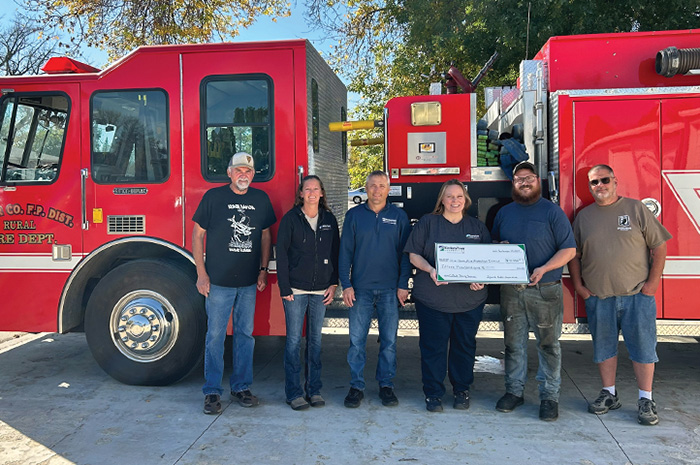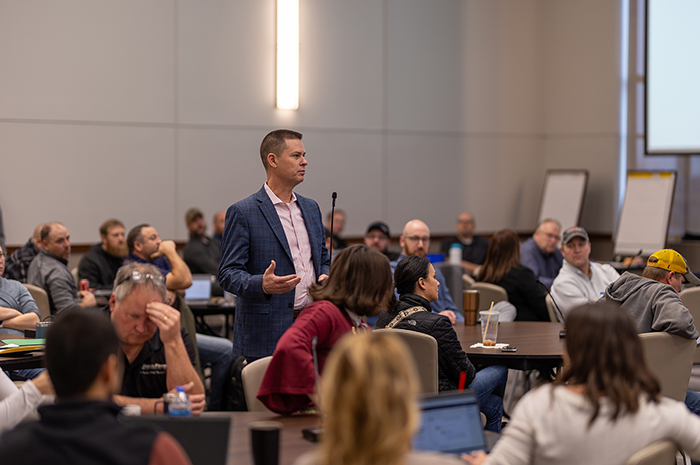5 questions with Matt Marshall, Minnkota's economic development administrator
Matt Marshall, Minnkota’s economic development administrator, answers our five questions on his role at Minnkota and how he is helping our members and municipals promote growth and opportunity in their service territories.
Creating connections and finding solutions is what Matt Marshall does best. Since starting in a brand new economic development administrator position at Minnkota in 2020, Marshall has been a conduit between Minnkota departments, member/municipal systems, communities and potential project developers. Working together in true cooperative fashion, these groups not only promote natural growth in Minnkota’s service territory, but also attract new investments that create resiliency and opportunity.
During his time at Minnkota, Marshall has navigated a pandemic and changing economic circumstances while helping bring a variety of projects from concept to reality – including a data center that won North Dakota Gov. Doug Burgum’s Economic Development Project of the Year in 2021.
Marshall sat down with us and answered five questions about the connections he’s made with Minnkota’s member and municipal systems, and why he is excited to continue assisting with their regional economic development efforts.
1. What opportunities do our rural areas have to offer potential companies coming to North Dakota and Minnesota?
Rural areas throughout the Minnkota territory have a lot to offer companies looking to relocate or start a business. A few good examples of things rural areas can offer businesses are locations that have underutilized utilities, low-cost land and buildings relative to locations in more densely populated areas. In some cases, we have underserved markets that allow companies to establish a foothold within a region right away. Other rural areas have financial assistance or programs that can assist businesses in expansions or relocations that are not available in large metro areas. Rural areas offer a chance for companies and their employees to “work where they play,” which has increased in importance as younger generations enter the workforce. Most of that success has been driven by individuals moving home with the ability to maintain their current job and the rural areas that have the housing inventory available have been able to capitalize on the new remote work opportunities.
2. How does your position help rural communities overcome challenges in recruiting businesses to their area?
My hat changes depending on where I am working. Some locations have local economic development folks and in those places I act in a supportive role by supplying leads, providing assistance with tasks or utilizing my expertise in any particular areas. In other locations, there may not be a local economic developer on staff so I tend to take on a more involved role as we work on projects. One of the major challenges our rural areas face is the lack of available real-estate inventory for a new or expanding business. In partnership with our members, we are constantly identifying new sites that can be marketed for development.
3. Why is it important to diversify the economy of our service territory?
Diversifying Minnkota’s territory is all about creating resiliency during downward economic trends thus making the region more stable for our member-owners. An added benefit to that diversification is the increased potential to recruit new workforce, which is a critical need for the vast majority of businesses within Minnkota’s territory. Additionally, new workforce would provide new residents in areas that have seen their population decline over the last several decades.
4. What has been the most rewarding project you’ve worked on since joining Minnkota?
One of the greatest aspects of being part of the economic development team at Minnkota is the ability to fully embody the cooperative principle of concern for community. It is extremely rewarding to see the sustainable growth take place after assisting businesses and communities. I enjoy helping entrepreneurs get the funding they need and watching their businesses thrive. Working with a community to help them attract a housing developer solve a critical housing need is also extremely rewarding. I have been fortunate to be a part of a team that gets help bring projects like those to life.
5. What do you foresee for our region in terms of economic development over the next few years?
While we will continue to focus on expanding existing businesses and attracting new industry to the region, community development efforts will still need to be a major focus. Businesses and communities within the Minnkota family are seeing their growth hindered because of the lack of workforce and population declines. This elevates the need for new housing solutions, child care and quality of life elements that may be needed to help attract people. The new remote work dynamic that has taken hold of the country the last couple of years is great opportunity for the rural areas in the Minnkota family and we are seeing some regions benefit from that transition already.
Main image: Matt Marshall (right) shakes hands with Chris West, mayor of Grafton, N.D., near the site for a new housing project that will help meet a community need. Housing options and availability are among the keys to driving economic development in the region.
...



